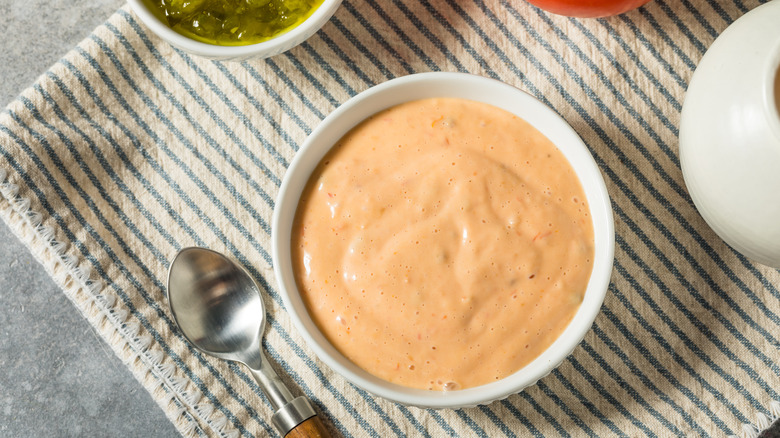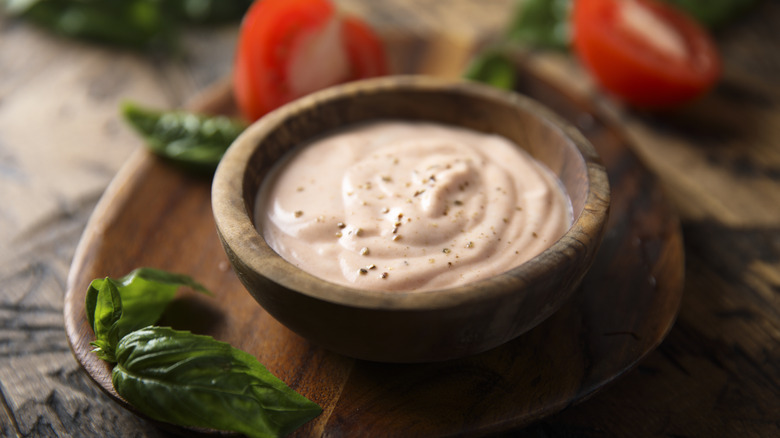The Mysterious Origins Of Thousand Island Dressing
On the list of classic American salad dressings, you might think of things like ranch, blue cheese, or Italian (which isn't actually from Italy) first. But there's another old American salad staple quite unlike any of the others, with a catchy name and an eye-popping visual draw: Thousand Island. Though there's no one unique recipe, it generally contains a mix of mayonnaise, ketchup, Worcestershire sauce, lemon juice, mustard, finely chopped pickles, and any number of spices. But where did Thousand Island dressing come from in the first place?
Well, it turns out there's some controversy there. Much like the origin of Buffalo Wings, we know where Thousand Island came from — the "Thousand Islands" area in Western New York on the border with Canada. But as far as the actual origin story itself, there are two competing theories on where it came from. Interestingly, both of them ultimately run through the same person: wealthy hotelier George Boldt of New York City's famous Waldorf-Astoria.
We know George Boldt was involved somehow
Located in northwestern New York State, right on the border with Canada, sits the Thousand Islands region, so-called because of the myriad small islands that dot the Saint Lawrence River. If "Thousand" in that title sounds like it couldn't possibly be right, you're correct — it's actually 1,864. It's also long been the home of the wealthy vacationing New York elite, and around the start of the 20th century, this included George Boldt, proprietor of the Waldorf-Astoria in New York. Boldt loved the area so much that he literally built a castle on an island there, now considered a tourist attraction.
According to legend, Boldt was out on his yacht one day when his steward, Oscar Tschirsky, realized he'd forgotten to bring any salad dressing. So he came up with something on the spot using what he had lying around — ketchup, mayo, pickles, etc — and that became Thousand Island dressing. If this story sounds just a little too fanciful for your tastes, though, there's another origin story. Incredibly, this one also involves Boldt — albeit a little less directly.
It could've been invented by a fisherman's wife
The Thousand Islands has no shortage of local fishermen, and in the late 1800s, one of them was named George Lelonde. Lelonde and his wife Sophia owned a restaurant, and as the story goes, Sophia came up with a sauce (creatively named "Sophia's Sauce") that George would share with all his fishermen pals. Eventually, he also shared it with an actress named May Irwin, a member of high society who loved the sauce so much she got the Lelondes to share the recipe with her. She would go on to share it with someone she knew: George Boldt. From there, Boldt popularized it — so one way or another, the sauce does still run through him.
Though this second story is less of a tale of coincidence than the first, it has the benefit of potential evidence by the way of a recipe allegedly discovered by a man named Allen Benas in The Thousand Islands Inn in 1972. Though there's no concrete proof the note is legitimate, it's still more evidence than exists for the other origin theory.
Whatever the true origin story, Thousand Island certainly contains a riotous mix of tastes that combine into a concoction that isn't just a salad staple, it's the key ingredient in great dishes like the Reuben sandwich. Whoever was responsible, be it Sophia Lelonde or Oscar Tschirky, we owe them a tremendous debt of gratitude.


